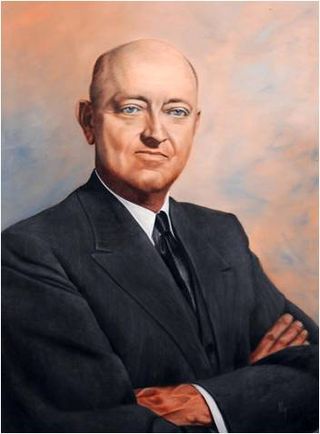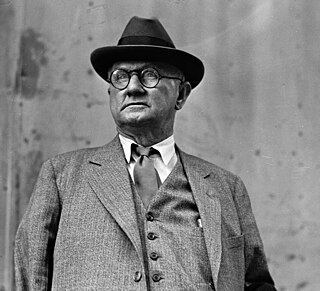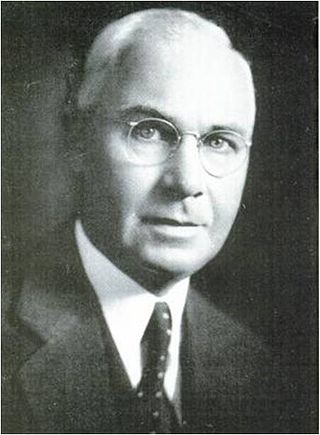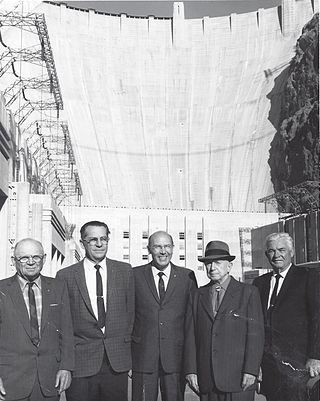
Hoover Dam is a concrete arch-gravity dam in the Black Canyon of the Colorado River, on the border between the U.S. states of Nevada and Arizona. It was constructed between 1931 and 1936 during the Great Depression and was dedicated on September 30, 1935, by President Franklin D. Roosevelt. Its construction was the result of a massive effort involving thousands of workers, and cost over 100 lives. It was referred to as the Hoover Dam after President Herbert Hoover in bills passed by Congress during its construction; it was named the Boulder Dam by the Roosevelt administration. The Hoover Dam name was restored by Congress in 1947.


Frederick Haynes Newell, served as the first Director of the United States Reclamation Service and was born in Bradford, Pennsylvania. He graduated in 1885 from the Massachusetts Institute of Technology and after field experience in Colorado and other states was appointed on October 2, 1888, as Assistant Hydraulic Engineer of the United States Geological Survey, being the first aide designated under Major John Wesley Powell to investigate the extent to which the arid regions of the United States might be reclaimed by irrigation. He was subsequently appointed Chief of the Hydrographic Branch.

The Colorado River Aqueduct, or CRA, is a 242 mi (389 km) water conveyance in Southern California in the United States, operated by the Metropolitan Water District of Southern California (MWD). The aqueduct impounds water from the Colorado River at Lake Havasu on the California-Arizona border, west across the Mojave and Colorado deserts to the east side of the Santa Ana Mountains. It is one of the primary sources of drinking water for Southern California.

Davis Dam is a dam on the Colorado River about 70 miles (110 km) downstream from Hoover Dam. It stretches across the border between Arizona and Nevada. Originally called Bullhead Dam, Davis Dam was renamed after Arthur Powell Davis, who was the director of the U.S. Bureau of Reclamation from 1914 to 1923. The United States Bureau of Reclamation owns and operates the dam, which was completed in 1951.

Francis Trenholm Crowe was a Canadian civil engineer and employee of Morrison-Knudsen, who later became in 1931, the General Construction Superintendent of the Hoover Dam construction contract.

Ulysses Simpson Grant III was a United States Army officer and planner. He was the son of Frederick Dent Grant, and the grandson of General of the Army and American President Ulysses S. Grant.

Elwood Mead was an American professor, government official, and engineer known for heading the United States Bureau of Reclamation (USBR) from 1924 until his death in 1936. During his tenure, he oversaw some of the most complex projects the Bureau of Reclamation has undertaken. These included the Hoover, Grand Coulee and Owyhee dams.

Folsom Dam is a concrete gravity dam on the American River of Northern California in the United States, about 25 mi (40 km) northeast of Sacramento. The dam is 340 ft (100 m) high and 1,400 ft (430 m) long, flanked by earthen wing dams. It was completed in 1955, and officially opened the following year.

John Ripley Freeman was an American civil and hydraulic engineer. He is known for the design of several waterworks and served as president of both the American Society of Civil Engineers and the American Society of Mechanical Engineers.
John Bogart was an American civil engineer from New York. He was appointed and elected to numerous public positions in the New York City metropolitan area. He also served at the state level, for instance as New York State Engineer and Surveyor from 1888 to 1891. As a consulting engineer, he participated in numerous large-scale projects across the country, ranging from parks to bridges and dams.

Ralph Arnold Tudor was an American builder, civil engineer and Under Secretary of the United States Interior Department. The Ralph A. Tudor Medal awarded by the Society of American Military Engineers is named for him.

John Walton Keys III was the Commissioner of the United States Bureau of Reclamation from 2001 to 2006. He was also a college football official for 20 years in the Big Sky Conference.

John Lucian Savage was an American civil engineer. Among the 60 major dams he supervised the designs for, he is best known for the Hoover Dam, Shasta Dam, Parker Dam and Grand Coulee Dam in the United States along with surveying for the future Three Gorges Dam in China. He was a member of the National Academy of Sciences and the recipient of numerous awards including the John Fritz Medal.

Harry Bolton Seed was an educator, scholar, former professor at the University of California, Berkeley. He was regarded as the founding father of geotechnical earthquake engineering.

Carl Ewald Grunsky was a geologist and civil engineer throughout the mid 19th century.

Bridge Canyon Dam, also called Hualapai Dam, was a proposed dam in the lower Grand Canyon of the Colorado River, in northern Arizona in the United States. It would have been located near Bridge Canyon Rapids in an extremely rugged and isolated portion of the canyon, 235 miles (378 km) downstream of Lees Ferry and at the uppermost end of Lake Mead.
Walter Mickle Smith, Sr. was a civil engineer who worked primarily on U.S. dams and waterway projects. He was a consulting engineer on the construction of the Panama Canal and Panama Canal Locks and later served as design engineer for the New York Board of Water Supply. He spent much of his career with the State of Illinois waterways division and was its chief engineer until his retirement in 1937. Several of his works built in the 1920s and 1930s as part of the Illinois Waterway project are listed on the National Register of Historic Places, including portions of the Brandon Road Lock and Dam, the Dresden Island Lock and Dam, the Lockport Lock and Power House, and the Marseilles Lock and Dam.

Louis Rea "Doug" Douglass was an American civil engineer. He spent more than 20 years with the United States Bureau of Reclamation and was in charge of Hoover Dam and the surrounding park land for four years.

Vannoy Hartrog Manning, better known as Van H. Manning, was the second director of the U.S. Bureau of Mines and was instrumental in developing chemical warfare defense technologies during World War I.


















